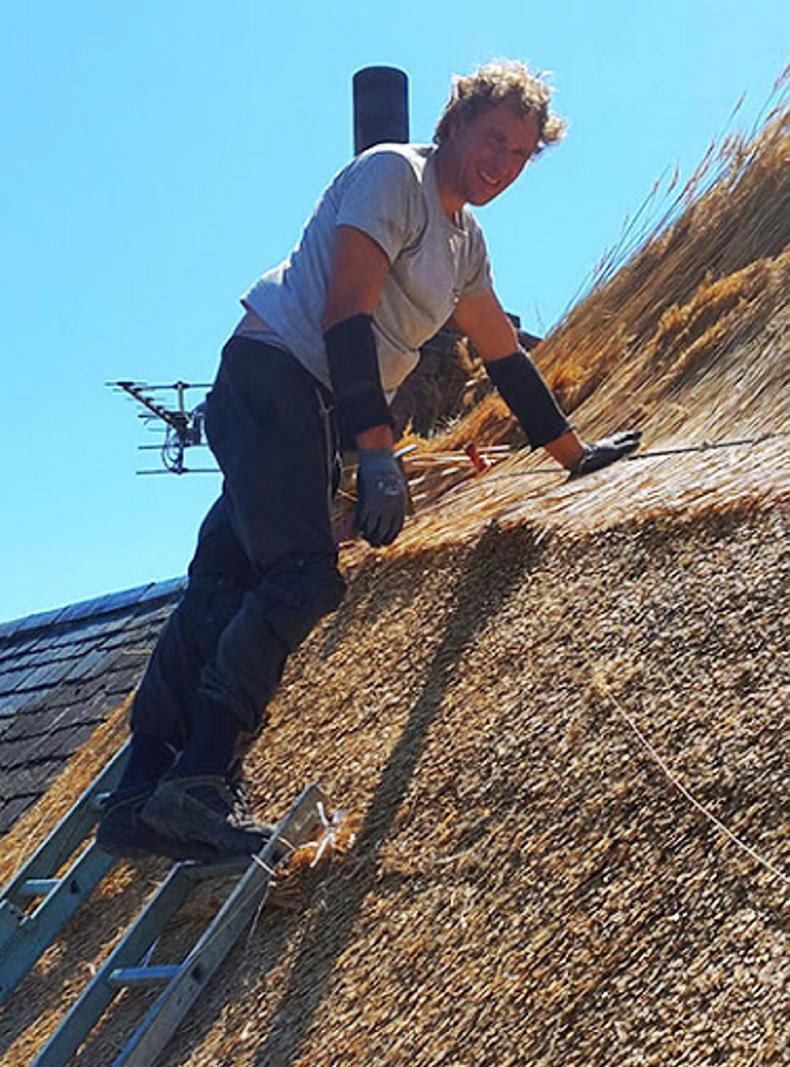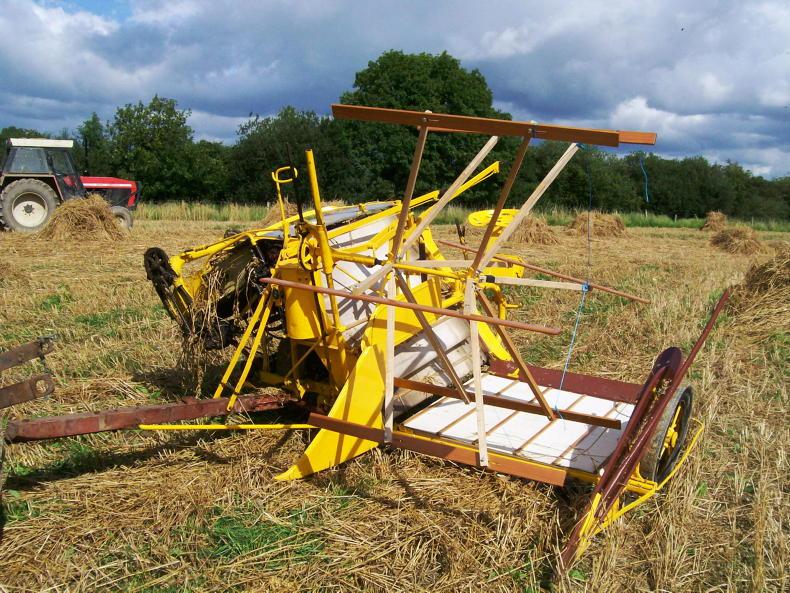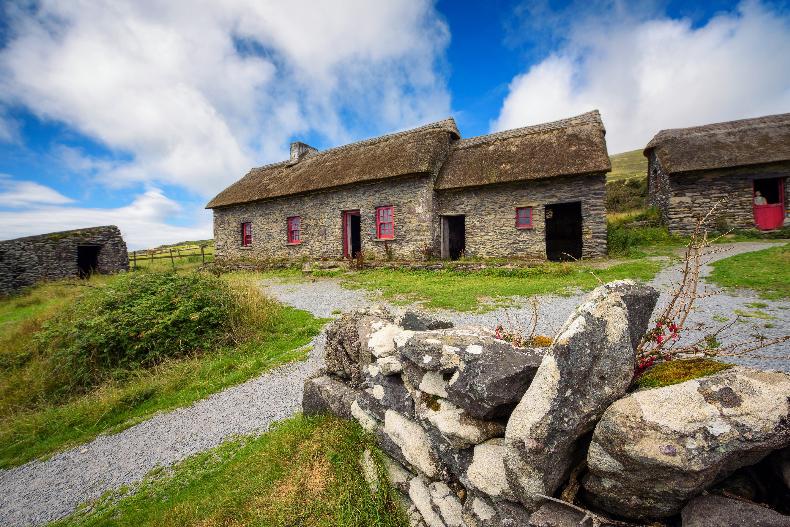In comparison to the early 20th century, when tens of thousands of thatched homes dotted the Irish countryside, the republic of Ireland is home now to approximately 1,800 thatched roofs.
Thatched houses evoke a lot of emotions; some people may feel that they belong in the past, while others see both the indigenous roof structure and traditional trade as one of very few remaining tangible links to our historical heritage.
Meet the maker
After a substantial number of dead-end phone calls and pointless web browsing through outdated websites – Irish Country Living found a thatcher.

In his previous life, Philip Doran trained and worked as an engineering technician. It was around 1999 that he decided to purchase property in rural Co Laois, eventually settling for an old cottage near Rathdowney. The original roof of the house was thatched. With this knowledge, Philip began looking at thatching in general and the costs associated with rethatching the building. After his research, he began to consider training in thatching and undertaking the work himself.
“Why not? I was comfortable working at heights and had helped neighbours in the past with their farm building. I always had a real interest and passion for old vernacular buildings, and especially old cottages. From what I could see, they were no longer being lived in; neglected and let fall to the ground. And all that was required to repair many of them was a good roof.”
Philip’s first step towards his new career was registering for a local training initiative with Lullymore Heritage Park, Co Kildare, where thatching was part of the course.
In July 2006, he completed a FÁS thatching course in Portumna, Co Galway. This programme covered all aspects of the trade, including practical, theoretical and technical knowledge in traditional reed and straw thatching skills. By then, Philip had acquired a good working knowledge of thruss thatching, but there were other aspects and styles of thatching that he wanted to know more about.
I had approached John Brereton, and explained to him that I wanted further training. He kindly offered to take me on for one job
“Brereton Family Thatchers in Kildare were a long-established family of traditional thatchers. I had approached John Brereton, and explained to him that I wanted further training. He kindly offered to take me on for one job. But we got on very well and I ended up staying nearly four years with his firm,” Philip recalls.
Following his many years of theoretical and practical experience with John, Philip established his own thatching business in 2008.
Crisis advancing
While Philip is grateful to have a full year of work ahead of him; he is intensely concerned for cottage owners, who soon will not be able to find a suitable person to maintain their thatch. The nationwide shortage of trained thatchers is bad news for the heritage trade and architectural legacy.
I could count on my fingers the number of working thatchers left in Ireland
“I cannot over emphasise how alarming the shortage of thatchers around the country is for cottage owners and for our heritage. There are simply no new people coming into the trade. That needs to be addressed, otherwise this industry does not have a future.
“Right now, I am the only registered thatcher between counties Laois, Offaly and Tipperary. I could count on my fingers the number of working thatchers left in Ireland. In fact, if you were to look at the list of registered thatchers provided online by the heritage council, many of those named are actually deceased. There is a crisis on the way.”
As it stands, if you want to train to be a thatcher you have to go to Knuston Hall in Northampton, England
I struggle to understand why young people – who are often the most protective of our culture – would not want to enter this rewarding trade. Since Philip completed his training with FÁS in 2006, there have been no formal thatching programmes available in the ROI.
“As it stands, if you want to train to be a thatcher you have to go to Knuston Hall in Northampton, England.”
Reaper binder straw
Despite its years of technological advancement, the modern combine harvester has no place in cutting straw for thatching.
The straw will bend and break as it goes through the combine drum and mill; leaving it too short and difficult for a thatcher to work with. Instead, an old-fashioned reaper binder is used to harvest thatch straw.

Albion reaper binder is used in harvesting straw for thatch
Both oat straw and wheat straw are used for thatching rooves. But it seems that recent straw shortages has impacted the thatcher, as much as the farmer.
“It is becoming very difficult to get good straw. Some people swear that the oat straw looks better. But wheat straw is a substantially stronger thatching material, believe it or not. That’s because it is more waterproof.”
And whilst many farmers would use bags of 10-10-20 fertiliser on cereal crops, a good crop of thatching straw requires less nitrogen (N) as it softens the straw; and more potash (K), as it gives strength to the straw stem.
Rewarding career
For Philip, learning to utilise various thatching materials and methods has been important for his career; ensuring he is well informed and able to cater for all his customers to a high standard.
“I have used reed from the all over the world. I would like to be able to use more Irish reed, but there are issues with both quantity and quality here in Ireland.
“As a result, I buy in reed from abroad. The best reed of all is Chinese reed, as it is really clean and free from nitrates.”
Describing the immense “buzz” and sense of pride he feels after each roof is finished or repaired, Philip is still passionate about the craft he fell for almost 20 years ago, as every site he approaches has a unique story beneath its rafters. But like any job, Philip says you must love what you do to excel.
It is a really rewarding career
“You need to have a real grá for this job, because you spend a lot of time working in inclement weather and you have to be tough both physically and mentally.
“But if you have the interest and gather experience, to get to a point where you can establish your own business, it is a really rewarding career,” he says.
Considering the conversation that is brewing in every corner of Dáil Éireann about the need to live and work more sustainably the huge insulation value a thatched roof adds to a home, as well as it being a 100% naturally sourced material, one would have to question why the traditional thatching trade receives little to no Government support.
If an opportunity arose that I could take on a young person for a few years, who is genuinely interested in making a career out of this – I would show them absolutely everything I know
And while Philip would delight in teaching his craft to the right trainee, he does fear that the age-old trade is a vanishing one.
“If an opportunity arose that I could take on a young person for a few years, who is genuinely interested in making a career out of this – I would show them absolutely everything I know. All we need is a handful of interested young people, to keep this trade going.
“But unless there is some serious action taken, I can’t see this trade surviving 20 or 30 years from now.”
Visit philipdoranthatcher.ie to see more of Philip’s craft work.
Read more
My Country Living: ‘When it comes to coopering you’re so connected to history’
MCL:'I was always intrigued and fascinated by the whole atmosphere of the forge'
In comparison to the early 20th century, when tens of thousands of thatched homes dotted the Irish countryside, the republic of Ireland is home now to approximately 1,800 thatched roofs.
Thatched houses evoke a lot of emotions; some people may feel that they belong in the past, while others see both the indigenous roof structure and traditional trade as one of very few remaining tangible links to our historical heritage.
Meet the maker
After a substantial number of dead-end phone calls and pointless web browsing through outdated websites – Irish Country Living found a thatcher.

In his previous life, Philip Doran trained and worked as an engineering technician. It was around 1999 that he decided to purchase property in rural Co Laois, eventually settling for an old cottage near Rathdowney. The original roof of the house was thatched. With this knowledge, Philip began looking at thatching in general and the costs associated with rethatching the building. After his research, he began to consider training in thatching and undertaking the work himself.
“Why not? I was comfortable working at heights and had helped neighbours in the past with their farm building. I always had a real interest and passion for old vernacular buildings, and especially old cottages. From what I could see, they were no longer being lived in; neglected and let fall to the ground. And all that was required to repair many of them was a good roof.”
Philip’s first step towards his new career was registering for a local training initiative with Lullymore Heritage Park, Co Kildare, where thatching was part of the course.
In July 2006, he completed a FÁS thatching course in Portumna, Co Galway. This programme covered all aspects of the trade, including practical, theoretical and technical knowledge in traditional reed and straw thatching skills. By then, Philip had acquired a good working knowledge of thruss thatching, but there were other aspects and styles of thatching that he wanted to know more about.
I had approached John Brereton, and explained to him that I wanted further training. He kindly offered to take me on for one job
“Brereton Family Thatchers in Kildare were a long-established family of traditional thatchers. I had approached John Brereton, and explained to him that I wanted further training. He kindly offered to take me on for one job. But we got on very well and I ended up staying nearly four years with his firm,” Philip recalls.
Following his many years of theoretical and practical experience with John, Philip established his own thatching business in 2008.
Crisis advancing
While Philip is grateful to have a full year of work ahead of him; he is intensely concerned for cottage owners, who soon will not be able to find a suitable person to maintain their thatch. The nationwide shortage of trained thatchers is bad news for the heritage trade and architectural legacy.
I could count on my fingers the number of working thatchers left in Ireland
“I cannot over emphasise how alarming the shortage of thatchers around the country is for cottage owners and for our heritage. There are simply no new people coming into the trade. That needs to be addressed, otherwise this industry does not have a future.
“Right now, I am the only registered thatcher between counties Laois, Offaly and Tipperary. I could count on my fingers the number of working thatchers left in Ireland. In fact, if you were to look at the list of registered thatchers provided online by the heritage council, many of those named are actually deceased. There is a crisis on the way.”
As it stands, if you want to train to be a thatcher you have to go to Knuston Hall in Northampton, England
I struggle to understand why young people – who are often the most protective of our culture – would not want to enter this rewarding trade. Since Philip completed his training with FÁS in 2006, there have been no formal thatching programmes available in the ROI.
“As it stands, if you want to train to be a thatcher you have to go to Knuston Hall in Northampton, England.”
Reaper binder straw
Despite its years of technological advancement, the modern combine harvester has no place in cutting straw for thatching.
The straw will bend and break as it goes through the combine drum and mill; leaving it too short and difficult for a thatcher to work with. Instead, an old-fashioned reaper binder is used to harvest thatch straw.

Albion reaper binder is used in harvesting straw for thatch
Both oat straw and wheat straw are used for thatching rooves. But it seems that recent straw shortages has impacted the thatcher, as much as the farmer.
“It is becoming very difficult to get good straw. Some people swear that the oat straw looks better. But wheat straw is a substantially stronger thatching material, believe it or not. That’s because it is more waterproof.”
And whilst many farmers would use bags of 10-10-20 fertiliser on cereal crops, a good crop of thatching straw requires less nitrogen (N) as it softens the straw; and more potash (K), as it gives strength to the straw stem.
Rewarding career
For Philip, learning to utilise various thatching materials and methods has been important for his career; ensuring he is well informed and able to cater for all his customers to a high standard.
“I have used reed from the all over the world. I would like to be able to use more Irish reed, but there are issues with both quantity and quality here in Ireland.
“As a result, I buy in reed from abroad. The best reed of all is Chinese reed, as it is really clean and free from nitrates.”
Describing the immense “buzz” and sense of pride he feels after each roof is finished or repaired, Philip is still passionate about the craft he fell for almost 20 years ago, as every site he approaches has a unique story beneath its rafters. But like any job, Philip says you must love what you do to excel.
It is a really rewarding career
“You need to have a real grá for this job, because you spend a lot of time working in inclement weather and you have to be tough both physically and mentally.
“But if you have the interest and gather experience, to get to a point where you can establish your own business, it is a really rewarding career,” he says.
Considering the conversation that is brewing in every corner of Dáil Éireann about the need to live and work more sustainably the huge insulation value a thatched roof adds to a home, as well as it being a 100% naturally sourced material, one would have to question why the traditional thatching trade receives little to no Government support.
If an opportunity arose that I could take on a young person for a few years, who is genuinely interested in making a career out of this – I would show them absolutely everything I know
And while Philip would delight in teaching his craft to the right trainee, he does fear that the age-old trade is a vanishing one.
“If an opportunity arose that I could take on a young person for a few years, who is genuinely interested in making a career out of this – I would show them absolutely everything I know. All we need is a handful of interested young people, to keep this trade going.
“But unless there is some serious action taken, I can’t see this trade surviving 20 or 30 years from now.”
Visit philipdoranthatcher.ie to see more of Philip’s craft work.
Read more
My Country Living: ‘When it comes to coopering you’re so connected to history’
MCL:'I was always intrigued and fascinated by the whole atmosphere of the forge'







SHARING OPTIONS